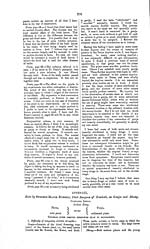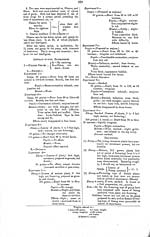Medicine - Drugs > Report of the Indian Hemp Drugs Commission, 1894-1895 > Volume IV
(291) Volume 4, Page 277
Thumbnail gallery: Grid view | List view

277
immature (i.e.,
not arrived at flowering stage)
plants used. All parts of the plant, except large
stems, used, not merely flowering tops of female
plants.
2. Influence of
maturity and flowering stage.
Compare directions for gathering plants used in
medicine.
(a)
General directions.—Herbs and leaves
should be gathered after flowers have
blown, and before fruit ripens.
(Garrod—Materia Medica,
8th edition, 1880,
page 179.)
(b)
Conii folia (Henbane)—Gathered when
two-thirds flowers have expanded.
(c)
Aconiti folia—Leaves and flowering tops,
gathered when about one-third of the
flowers have expanded.
(d)
Hyoscyami folia (Hemlock)—Gathered
when two-thirds of the flowers are
expanded.
(e)
Belladonna folia—Gathered when fruit
has begun to form.
Conclusion.—In
comparing ganja and bhang
their relative strength can only be determined by
testing similar parts of the plants at a similar
stage of their existence.
During
flowering—Plants innocuous at other
times, may secrete poisonous properties : e.g.,
parsnip
root (Petroselenum sativa) sometimes
does this (Balfour, Botany, page 508).
3.
NOTE.—Cultivated versus wild plants, gene-
rally.—Compare those used for active principles
in medicine:—
(a)
Cultivated or wild indifferently, cœteris
paribus.
Belladonnœ
folia.—Leaves from wild or cul-
tivated used (Garrod—Materia Medica, page 319).
Hyoscyami folia.— ditto ditto (idem).
(b) Wild plant only used—
|
Conii folia (Henbane.) |
|
|
in medicine. |
|
|
Digitalis folia (Fox glove.) |
(c) Cultivated plant, only used—
Aconiti folia In medicine.
Conclusion.—Little
to be argued from general
analogy.
4. NOTE.—ANALOGY OF HEMP AND HOP.
Cannabinacœ.—Natural order.—Hemp and
Hop
family.
In the Hop the female
strobili (flowering heads
or cones) contain the active principle in a resin
secreted round the scales. Leaves inactive.
In cultivated Indian hemp
(ganja) active prin-
ciple chiefly in female flowering tops. These alone
sold and used in medicine.
Wild Indian
hemp.—Analogy suggests a similar
arrangement of active principle, and that leaves
of immature plants should be almost innocuous.
5. NOTE.—Opium
eating and ganja consuming.—
It is very common to find the
same person habi-
tually consume both opium and ganja.
Persons who begin
primarily as opium consumers
commonly diverge also to ganja.
Persons who begin
primarily as ganja con-
sumers do not so commonly diverge to opium.
6. Methods of using ganja and bhang:—
(a)
Smoking ganja.—Both ganja and bhang
are kneaded up with tobacco, and
smoked, with or without addition of
spices.
Ganja is commonly so used; bhang rarely.
(b) Drinking, or
eating.—Ganja is usually
prepared as majum.
Preparation.—The ganja is
steeped in water
(cold or hot) for 24 hours, filtered, and the fluid
mixed in sweetmeats. This is usually done by
professional sweetmeat makers. The consumer
orders these to be made strong or weak according
to inclination:—
Weak, say, 20 grains per man.
Strong, say, 40 to 60 grains per man.
Bhang prepared as goonta.
Preparation.—Some fresh or dried leaves are
pounded up and washed well in cold water. This
washing continued for ten minutes; the resulting
fluid filtered through thin cloth. The matter left
on the cloth again washed in water and filtered;
process repeated four or five times. Black pepper
(equal to half or whole weight of the bhang used)
added; also some sweet matter, as gur, sugar, etc.
This fluid is well frothed up, and drunk on
subsidence of the froth.
The fluid is a turbid, bilious-green liquid, of
sweet, mawkish taste, of smell like hay.
Thus goonta (bhang) is a rapidly improvised
drink; majum is a more formal
preparation.
7. Time in which effect produced—
(a) Smoked.—Ganja produces effects
almost
immediately; Bhang more slowly.
(b) Eaten, or drunk—
Majum (ganja) : effects come on in half an
hour or so.
Goonta (bhang) :
effects come on only after
three or four hours.
8. Duration of effects—
Ganja, in small doses,
or in persons habituated
to it: the effects last about three or four hours.
During a debauch, a person desirous to continue
under its influence repeats his dose every three or
four hours.
In large or
repeated doses, or in persons not
accustomed to it, effects may last three to five or
six days. Cases are related of permanent mental
derangement following excessive
doses.
Bhang.—Effects
rarely last more than from
four to twelve hours, however large the
dose.
Notes on Cannabis
Indica (Indian
Hemp)
|
Cultivated, |
versus |
Wild plant, |
|
i.e., ganja. |
i.e., bhang. |
Experiments by E. G.
RUSSELL, GAUHATI,
March 1883.
EXPLANATIONS.
1. In these notes—
Ganja=Flowering
tops of female plant of
cultivated Indian hemp.
Bhang=Leaves of wild Indian hemp.
Majum=Fluid preparation of ganja.
Goonta=Fluid preparation of bhang.
Set display mode to: Large image | Zoom image | Transcription
Images and transcriptions on this page, including medium image downloads, may be used under the Creative Commons Attribution 4.0 International Licence unless otherwise stated. ![]()
| India Papers > Medicine - Drugs > Report of the Indian Hemp Drugs Commission, 1894-1895 > Volume IV > (291) Volume 4, Page 277 |
|---|
| Permanent URL | https://digital.nls.uk/74552832 |
|---|---|
| Description | Evidence of Bengal witnesses. |
| Description | Volume 4: Evidence of witnesses from Bengal and Assam. |
|---|---|
| Attribution and copyright: |
|




